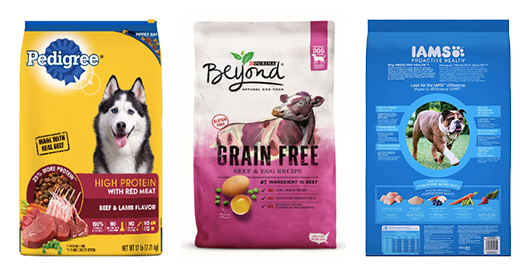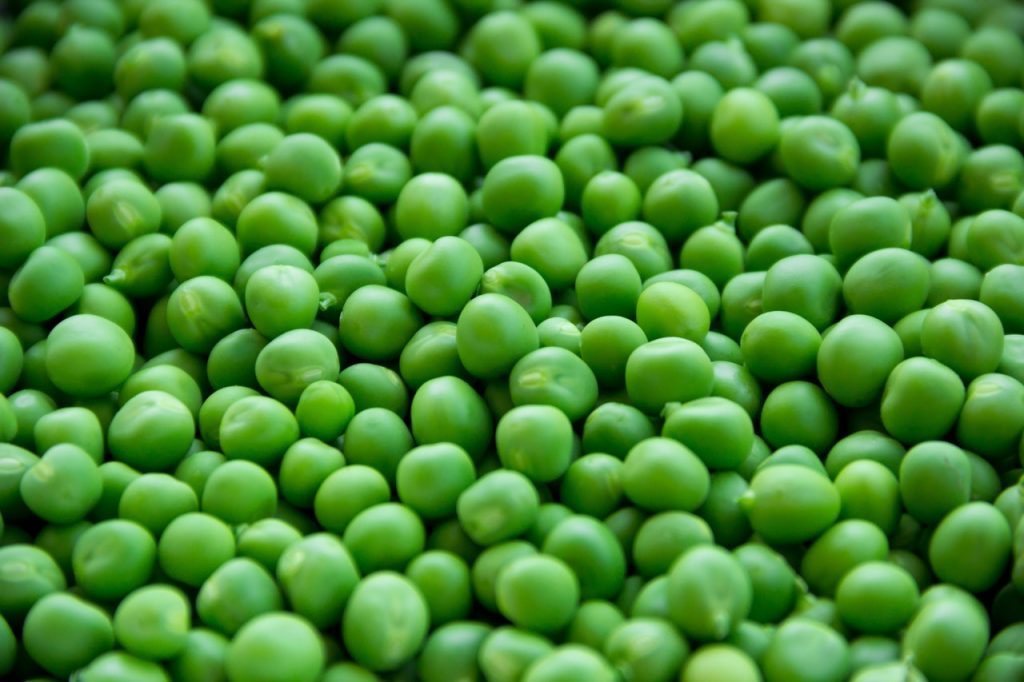“Nutritionally balanced”, “holistic health”, “essential nutrients”, “grain-free”. Does any of this sound familiar? When choosing dog food, we gravitate toward clever marketing that makes it seem like we are feeding our dogs healthy food. Dog food companies dress up bags with brightly colored packaging, images of whole foods like peas or cuts of meat, and a healthy looking dog and then sell it at a hefty price tag. VOILA! We are sold.
Fitdog understands that reading the ingredients and understanding what they mean is overwhelming, so we’re here to help you by breaking down how companies trick you with labels. Let’s uncover some of the pet food industry’s dirty secrets.
5 ways to decode dog food labels
1. Check for the order of ingredients
Take PEDIGREE® Dry Dog Food Adult Roasted Chicken, Rice & Vegetable Flavor. Sure, the packaging has pictures of chicken, peas and a happy dog. Looks good enough, right? But let’s check out the order of ingredients:
- Ground whole grain corn
- Poultry By-product meal (source of glucosamine and chondroitin)
- Corn gluten meal
- Animal fat (source of omega 6 fatty acids)
- Meat and bone meal (source of calcium)
- Soybean meal
- ground whole grain wheat
- Brewers Rice, natural flavor
- Chicken by-product meal
So, what does it all mean? Pet food companies are not required to disclose what percentage of the total pet food is chicken or rice or any ingredient. That information is considered a ‘recipe’ and would be proprietary. Instead, ingredients of pet food are listed in order of pre-cooking weight, heaviest ingredient to lightest ingredient.

Simply put, whatever is #1 on the list is what the dog food is made up of most, and it descends in weight from there. As you can see from the list above, chicken isn’t even mentioned until ingredient #9, yet their marketing promotes the fact that chicken is the main ingredient. Not to mention that the “chicken” is actually “chicken by-product meal”. This brings us to our next decoding tip.
2. Not all protein is created equal
Common “meats” are listed under many other aliases and forms. The short of it is that you want your dog to be eating “chicken” not “chicken by-product” or “chicken meal”. (Checkout PetMD Pet Food Guide by Dr. Donna Spencer.)
By-products
Chicken by-products or beef by-products are clean, non-rendered “parts” other than meat derived from slaughtered mammals which includes stuff like lungs, spleen, kidneys, brain, blood, bone, fatty tissue and stomachs and intestines freed of their contents. This is a cheap way for pet food companies to keep the protein levels “high” (although not high quality) while keeping food production costs low.
Meat Meal
Meals, like Lamb Meal, includes all lamb tissues, exclusive of blood, hair, hoof, horn, hide trimmings, manure, bone, stomach and rumen contents that are cooked (rendered). After cooking, the dried solids are added as “meal” to pet food. Not any actual meat here! It ends up becoming a white powder that is:
- Not easily digestible
- Has no real nutritional value
- Creates ash in the food (which is hard to digest)
Canola Oil/Canola Meal
Canola oil is used in the farming industry to give a protein supplement to cows, swine and other live stocks. Since it tends to have a high protein reading, a lot of dog food companies will pair it with cheap products to help boost the protein level. For example, Pedigree uses the corn gluten meal for this purpose in their food. It’s also not very palatable.
Digest
Material from mammals which results from the chemical breakdown of clean meat tissues or by-products (“parts” other than meat). This is often used to give food “flavor.”
The big takeaway, if by-product and meals are the first ingredients in your dog’s food, your dog is not getting healthy nutrition.
3. Grain-free does not mean it is better
Thanks to clever marketing, we all think grain-free products are better. Sure, grain-free products have less carbs and could be easier for your dog to digest, but it is also important to know what your food is when it isn’t grain-free.
Grain binds kibble together and helps form the round balls. Otherwise, it would be just a bunch of powder for your dog to eat, which doesn’t look too appetizing to anybody. So, the dog food industry had to find another way to bind the kibble together, and they found that peas can actually do the job. Sounds fine, right? Keep reading!

Too many peas can be very bad for dogs. Peas contain lectin proteins, which are a plant’s natural defense. While birds can digest these proteins, carnivores cannot. And since lectins are sticky, binding proteins, they attach to leptin receptors which regulate carbohydrates into glucose. In time, they can disrupt these receptors which lead to diabetes, obesity, and cardiovascular disease. Sound familiar? These conditions are very prevalent in humans and pets today. Lectins also attach to villi in the digestive tract which can block absorption of nutrients.
Dog food companies have to put SO many peas in grain-free dog food that, as we learned from tip #1, it should become the first ingredient in grain-free dog food. But, it never is. How do they get around that?
4. Check for ingredient splitting
Ingredient splitting can be defined as breaking down one lower-quality item into its various components and listing each of them separately onto the pet food label. Now the meat appears higher on the list, even though there is actually less of it in the food. Sneaky, right?
It gets sneakier. If you take all the different pea ingredients and put them together, they would actually weigh more than the meat. They do this so that the first ingredient is something seemingly “healthy,” easier to market, or so they can say that the first ingredient is meat.

In the example of grain-free dog food using peas, you can usually find either pea flour, pea protein, or pea fiber in the ingredients.
This is done with lots of other things like corn and other vegetables. Make sure your pet foot label simply says “Peas”, and that it’s not broken down farther down in the ingredient list.
5. Read past the first 5 ingredients
Finally, there are many other food additives that should be avoided altogether. Poor quality food is frequently disguised with corn syrup, propylene glycol, and MSG . Plus these ingredients make the food damp and moist and more attractive to dogs.
Also, watch out for artificial colorings. Coloring is used for one reason: to make the food attractive. It has no nutritional value and can be responsible for food allergies.
Many preservatives are also known to be carcinogens in humans (and we’re feeding them to our dogs). Here is a list of preservatives to be avoided: BHA, BHT, sodium nitrite, and nitrate. Pets are smaller than humans, yet their food can have the same amount of preservatives as ours.
Fitdog approved dog food
So now that you are a dog food expert, what foods are safe? We made it easy for you by listing some of our favorite dry food kibble. Some of them may include meal or by-product, but taken as a whole, these brands work hard to make healthy food for your dog. This list does not include raw, freeze-dried or dehydrated dog foods (which we also like, but are not mentioned in this article!).
Fitdog Recommended:
- Orijen
- Lotus
- Acana
- Stella and Chewy’s Raw Coated Kibble
- Merrick
Not Recommended:
- Pedigree
- Beneful
- Iams
- Purina
- Science Diet and Royal Canin – However there are Rx diets that would be an exception to this.
Happy dog food shopping!
Let us know in the comments about what you feed your dog and any concerns you have about the dog food.
SOURCES: